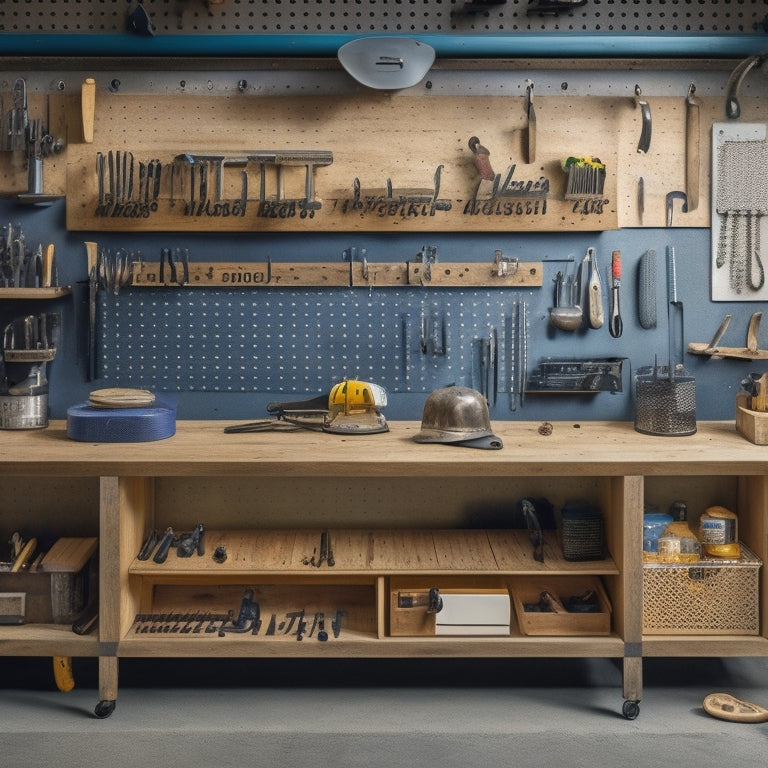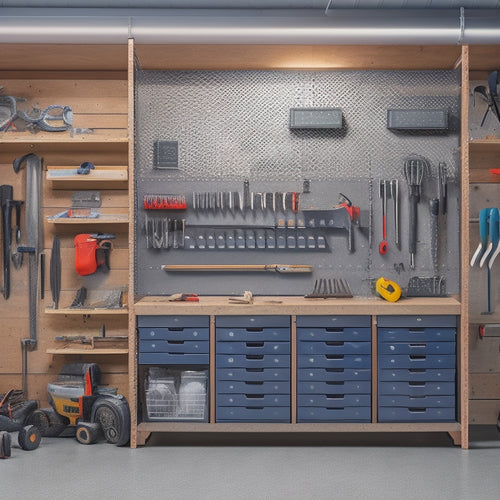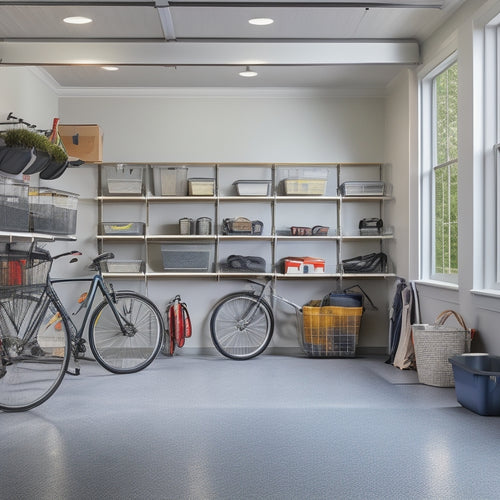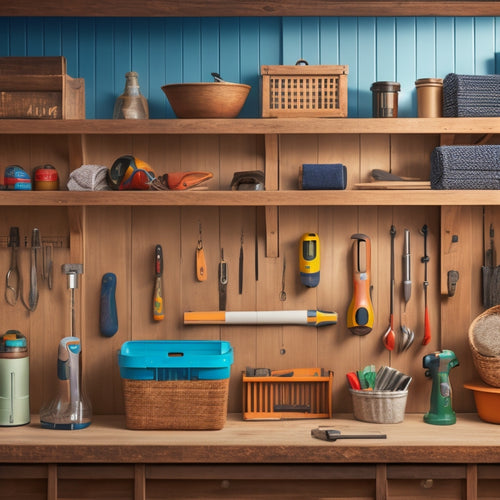
Organize Your Tool Collection With Custom Solutions
Share
You've invested time and money into your tool collection, now it's time to maximize their potential with a customized storage system. Start by evaluating your available storage space, identifying areas for optimization, and prioritizing tools based on frequency of use. Explore online tool holder options to create a personalized system that streamlines your workflow and reduces clutter. Consider tool size, shape, and weight to design ideal holders with custom features. With a well-organized system, you'll save time, reduce fatigue, and enhance productivity. Now, take the next step to transforming your workspace into a hub of efficiency.
Key Takeaways
• Evaluate available storage space and identify areas for optimization to create a tailored tool organization system.
• Design custom tool holders with features that cater to specific tool sizes, shapes, and weights for efficient storage.
• Maximize vertical storage space by utilizing wall space with hooks, bins, and pegboards to triple storage capacity.
• Arrange tools in a logical and accessible manner, considering Workzone Flow and Ergonomic Paths, to enhance workflow efficiency.
• Group similar tools together, labeling and signing for easy identification, to simplify tool selection and reduce search time.
Tool Storage Space Assessment
Take stock of your available storage space by walking through your garage, basement, or shed and identifying areas that can be repurposed or optimized for tool storage. This is the first step in organizing your tool collection.
As you walk through, take note of the storage constraints you're facing. Are there cluttered shelves, messy corners, or wasted space? Make a mental note of these areas, as they'll be your priority for optimization.
Conduct a toolroom audit to identify what you have and what you need. This will help you determine the type of storage solutions you require. Consider the size, shape, and weight of your tools, as well as how frequently you use them.
Think about the tools you use daily, weekly, and monthly, and prioritize storage for those items.
Customizable Tool Organizers Online
Now that you've assessed your tool storage space, it's time to explore customizable tool organizers online that fit your specific needs.
You'll find a range of tool holder options, from bins and baskets to pegboards and hooks, allowing you to create a personalized storage system.
Tool Holder Options
You can design your ideal tool holder online with customizable tool organizers that cater to your specific tool collection and storage needs. This means you can create a tailored solution that fits your unique requirements, rather than settling for a one-size-fits-all approach.
Imagine having a tool holder that perfectly accommodates your most frequently used tools, with:
- Tool trays that slide out for easy access to your screwdrivers and pliers
- Magnetic grips that securely hold your wrenches and sockets
- Adjustable dividers that separate your tools into logical categories
With customizable tool organizers, you can create a system that streamlines your workflow and reduces clutter. You'll spend less time searching for misplaced tools and more time getting the job done. Plus, you'll be able to easily add or remove tools as your collection evolves.
Personalized Storage Systems
By designing personalized storage systems online, you can specify the exact dimensions, materials, and features that fit your unique tool collection and workshop layout.
This level of customization guarantees that every tool has its designated spot, making it easy to find what you need when you need it.
With online design tools, you can choose from various materials, such as wood, metal, or plastic, and select the perfect finish to match your workshop's aesthetic.
You can also add features like drawers, cabinets, or pegboards to create a system that's tailored to your specific needs.
Maximizing Vertical Storage Space
When maximizing your vertical storage space, you'll want to optimize shelf height to accommodate tools of varying sizes.
You'll also need to utilize wall space by installing hooks, bins, or pegboards to hang items like bikes, hoses, or accessories.
Optimize Shelf Height
Maximizing vertical storage space starts with optimizing shelf height, which allows you to fit more tools in a smaller footprint while keeping frequently used items easily accessible. By doing so, you'll create a more efficient and organized workspace.
When designing your shelves, consider your personal preferences and needs. Think about the tools you use most often and how you can place them at a comfortable height to reduce strain and fatigue.
Here are some tips to keep in mind:
-
Shelf ergonomics: Position shelves at a height that allows you to stand upright with your arms at a 90-degree angle, reducing strain on your back and shoulders.
-
Shelf aesthetics: Choose shelf materials and designs that complement your workspace's style and theme, creating a visually appealing environment that inspires productivity.
-
Customization: Consider adjustable shelves or modular systems that can be tailored to your specific needs, ensuring that your tools and equipment are always within easy reach.
Utilize Wall Space
You can triple your storage capacity by utilizing wall space, which is often overlooked in many workshops and garages. By installing shelves, hooks, and bins, you can turn your walls into functional storage areas. This not only frees up floor space but also keeps your tools and equipment within easy reach.
Consider adding a pegboard, where you can hang frequently used tools, like hammers and screwdrivers. You can also install a slatwall with baskets and bins to store smaller items like nuts and bolts.
To add some style to your wall storage, incorporate wall decor elements, such as a vintage tool display or a motivational quote. Make the most of your wall space by using space savers like foldable workbenches and retractable tool holders.
These clever solutions will help you maximize your vertical storage space without sacrificing style or functionality. By utilizing your wall space effectively, you'll be able to store more tools, work more efficiently, and enjoy a more organized workshop or garage.
Designing Efficient Tool Layouts
Your workshop's best tool layout hinges on a thoughtful arrangement of frequently used tools in a way that minimizes walking distances and maximizes accessibility. This means designing a layout that considers your Workzone Flow, ensuring you can move efficiently between tasks without obstruction.
To achieve this, focus on creating Ergonomic Paths that reduce strain and discomfort.
Consider the following key elements to enhance your tool layout:
- Place heavy, frequently used tools at waist level to minimize bending and straining.
- Position tools with similar functions together, such as grouping all cutting tools or measuring devices.
- Leave enough space between tools to accommodate your hand movements, avoiding cramped and cluttered areas.
Tool Pegboard Configuration Options
With a well-designed pegboard, frequently accessed tools hang within easy reach, freeing up valuable workbench space and streamlining your workflow. You can choose from various pegboard patterns to suit your tool collection. For instance, a grid pattern allows for maximum flexibility, while a radial pattern is ideal for tools with varying handle lengths. You can also create custom layouts to accommodate your most-used tools.
Consider grouping similar tools together, such as all your screwdrivers or pliers, to enhance efficiency.
When configuring your pegboard, think about the tools you use most often and place them in easy-to-reach locations. You can also add labels or signs to identify the tools, making it easier to find what you need in a hurry. Don't be afraid to experiment with different layouts until you find one that works best for you.
Optimal Storage for Power Tools
Power tools, like drill presses and circular saws, require dedicated storage solutions that protect them from damage and keep their cords organized. You want to make sure that your investments are safeguarded and ready for their next use.
When it comes to ideal storage for power tools, consider the following essential elements:
-
A sturdy, closed cabinet or chest with individual compartments to separate tools and prevent scratching or tangling
-
A cord management system, such as hooks or straps, to keep cords tidy and prevent tripping hazards
-
A soft, padded interior or dividers to cushion tools and prevent damage during storage
Streamlining Tool Accessibility
Now that you've safeguarded your power tools, it's time to focus on streamlining their accessibility, so you can quickly grab the right tool when you need it. A well-organized tool collection is about more than just storage; it's about making your workflow more efficient.
To achieve this, consider the layout of your workspace. Place frequently used tools in easy-to-reach locations, and group similar tools together. This will save you time and energy in the long run.
Ergonomic handles can also make a big difference in your workflow efficiency. Look for tools with comfortable grips that fit nicely in your hand. This will reduce fatigue and allow you to work for longer periods without discomfort.
Additionally, consider investing in tool holders or trays that can be mounted on your workbench or wall. These will keep your tools organized and within reach, freeing up valuable space in your workshop.
Frequently Asked Questions
How Do I Prevent Rust and Corrosion in My Tool Storage System?
Ensuring that your tools are kept dry and cool is crucial for preventing rust and corrosion. This can be achieved by using rust inhibitors on your tools, storing them in a dry area, and maintaining climate control to prolong their lifespan.
Can I Customize Organizers for Specialized or Oversized Tools?
You can definitely customize organizers for your specialized or oversized tools. With laser cutting, you can create precise fittings, and modular design allows you to mix-and-match components for a tailored solution that fits your unique needs.
Are There Any Eco-Friendly Tool Storage Options Available?
You'll be happy to know that many eco-friendly tool storage options are available, featuring sustainable materials and recycled products that reduce waste and minimize environmental impact, aligning with your values and promoting a greener workspace.
How Often Should I Clean and Maintain My Tool Organizers?
'Like a fresh canvas, your tool organizers crave regular maintenance to stay efficient! You should clean and maintain them every 3-6 months, scheduling it in your organization calendar, and take stock of your tool inventory to make sure everything has its designated spot.'
Are There Any Safety Considerations for Storing Sharp or Heavy Tools?
When storing sharp or heavy tools, you'll want to prioritize safety. Make sure you have Tool Insurance, post Hazard Signs, and keep them out of reach of kids and pets to avoid accidents.
Related Posts
-

Building a Wall Tool Storage System
You're about to create a customized wall tool storage system that streamlines your workflow. Start by clearing your w...
-

Bin Garage Storage Ideas for Maximizing Space
You can greatly maximize your garage's storage space by utilizing vertical space with ceiling storage bins, stacking ...
-

What Tools Do I Need for a DIY Wall Organizer
You'll need a variety of tools to complete a DIY wall organizer project. Essential measuring tools include a tape mea...


